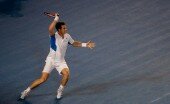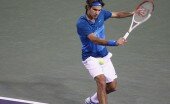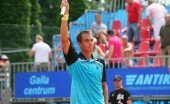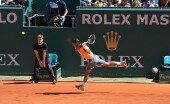Roland Garros and the Prospect of a New Champion
Written by Suhrith // May 21, 2011 // Sport // 5 Comments
Of all the Grand Slam tournaments, I love the French Open – or if you prefer, as I do, its more endearing name, Roland Garros – the most. This is seemingly an odd choice. Most people are entranced by Wimbledon and its exquisite grass courts and its glorious history – it is after all the home of tennis. But Roland Garros has a matchless charm to it. The ‘terre battue’ – the handsome red clay – the sublimity of the Parisian weather, the official trilby hat adorning the head of most people in the crowd, add to the allure of the tennis, which is more varied than on any other surface.
Tennis at Roland Garros is the ultimate test of endurance. Best of five set matches filled with long, draining rallies that encompass the full repertoire of a tennis player’s armoury – baseline strokes heavy on top spin, rallies filled with cheeky drop shots and lobs hit with diverse spin means that very often the dominance over a single rally can swing like a pendulum. A player who looks crushed one moment can still recover to win a point, provided of course he possesses the wherewithal to do so. But the fact that the surface offers such an opportunity means that it very often makes for a riveting spectacle.
This year’s tournament, which commences tomorrow, has the potential to be particularly memorable. In what is sure to beggar the belief of the more casual tennis fans, Rafael Nadal will not begin as the overwhelming favourite. Not too long ago, a few days before the Australian Open began, I asked where the next Federers and Nadals were. Since then, Novak Djokovic has gone on a 37-0 winning run (39-0 if one includes his victories in December), emerging triumphant in seven tournaments, including at Melbourne, rendering my question gloriously futile. Its futility, though, is not because Djokovic is on the verge of entering the pantheon of great tennis players – which he may well do at some point in his career – but because his winning streak has convincingly shattered the existing duopoly at the top of the men’s game.
Djokovic’s run has seen him defeat Nadal in four finals, two of which were on clay, a surface on which the Spaniard is, but for Bjorn Borg, recognized as the greatest exponent. As winning streaks at the start of a year go, the Serb trails only John McEnroe, who won 42 consecutive matches in 1984, at a time when even by McEnroe’s own admission, tennis wasn’t as demanding as it is today. The numbers, though, as remarkable as they may be, tell only a part of the story.
It is Djokovic’s assurance in the big games, and his tremendous ball-striking abilities on the tennis court, which he has paraded never more dazzlingly than in recent months that have been most spectacular. He possesses an innate sense of the geometry of a tennis court, enabling him to convert defence into attack – perhaps his greatest virtue – in the matter of a single stroke, irrespective of his position on the court. But then, these are assets that he has always possessed even if they have been sharpened in recent times. What is it then that has been the chief factor behind his ascent? Some say it has to do with his new gluten-free diet, while others point towards Serbia’s victory in the Davis Cup last December from which he has gained enormous self-confidence. Perhaps, it has to do with an astonishing improvement to his game – his forehand is a far more assured stroke now and his serve, once an unreliable weapon at times of crises has never been more secure.
If I were asked though to isolate a turning point, a seminal moment that has contributed towards his rise, I would find it difficult to look beyond his victory over Federer in the 2010 US Open semifinals. Very often, a player even of the richest talents can lack the self-confidence required to make the most of his skills. Djokovic, since his Australian Open victory in 2008 has regularly reached the latter stages of Grand Slams only to succumb to big-match pressure. Against Federer, though, at Flushing Meadows, down two match points on his serve at 4-5 in the fifth set, he produced a brace of breathtaking winners that have set him on the path towards the number one ranking. Admittedly, he lost in the final to Nadal, but the match was played a day after his grueling five setter against Federer. A loss at the season ending Masters in London to Federer in the semifinals may indicate that his victory at New York wasn’t after all so seminal. But by that time his focus had been diverted to the Davis Cup final at Belgrade, which he helped Serbia clinch with a display of tennis that was as exhilarating as it was sublime.
Since then his deeds have been well documented. He says he doesn’t believe he is unbeatable – and rightly so – but he plays his tennis with a sagacious serenity in spite of sprinklings of madness between points. A scream in agony or a tennis racquet broken in rage have never brought the best out of anyone, in recent times, in the manner in which it seems to, from Djokovic.
From a French Open perspective, it is his form in Madrid and Rome that serve as the key talking points. In neither tournament was his progress to the final seamless. At Madrid he won tough three-setters against David Ferrer and Thomaz Belluci in the quarterfinal and semifinal respectively. At Rome he was on the verge of elimination in the semifinal against Andy Murray, but his newfound self-belief saw him through, ultimately via a tiebreaker in the deciding set. Crucially, though, against Nadal, both at Madrid and Rome, Djokovic clinched victory in two straight sets. He was able to up his game when it mattered most – a sign that he has indeed come of age. The victories were so utterly imperious. In both matches, he pulverized Nadal from the back of the court, constantly directing his backhands crosscourt to the Spaniard’s forehand – widely recognized as his strong suit. Nadal has won Roland Garros five times in the last six years and it may be imprudent to not consider him as the favourite. But his title has perhaps never been at greater risk than it is in the coming fortnight, at the end of which, we may well have a new man at the summit of men’s tennis.





5 Comments on "Roland Garros and the Prospect of a New Champion"
Excellent Post Suhrith.
In addition to the prospects of a new champion in Djokovic, this and the next few tournaments are going to have an important bearing on the standing of Nadal amongst the all time greats. Till now, Nadal’s most effective weapon was his high topspun forehand to the opponents’ backhand forcing errors and weak returns he could easily finish. Clearly, Djokovic has found the most effective response to this tactic through his strong double hander combined with the phenomenal use of the court geometry. Additionally, his aggressive returning has put Nadal’s serve under the gun, a long-standing unexploited weakness in Nadal’s game.
Nadal therefore, needs to re-align his game, possibly be more aggressive in his groundstrokes and serve, and come forward more often. Additionally, Djokovic’s recent mastery of Nadal might rub off on others as well. I see a pattern in Nadal’s losses to players with heavy groundstrokes and strong double handed backhands (Del Potro, Soderling, Davydenko, and Djoker of course).
Incidentally, something similar happened to Roger Federer as well. Seemingly having no weaknesses in his early years at least until 2006 (Agassi writes about it in his book), Nadal exposed Federer’s inconsistent backhand in the series of their meetings on clay. While Federer tried to counter the problem initially by running around it, declining fitness levels and slower movements have made it impractical and often ugly in his later years.
Lets see how Nadal responds! Interesting times for tennis – I can’t wait for RG to start !
Thanks a lot for the comment, Rohan. It’s a very valid point you make, about Nadal struggling against players with strong double handed backhands. He has also struggled on the odd occasion against Murray, who I am still hoping can muster some kind of championship form.
Excellent Post, Suhrith
Your English is very grand
Keep it up
UGITH
If some one desires expert view regarding blogging and site-building after that i recommend him/her
to pay a visit this webpage, Keep up the pleasant job.
Trackbacks for this post